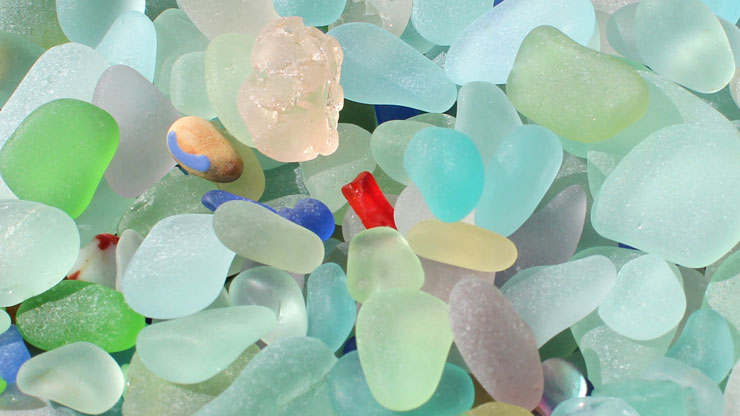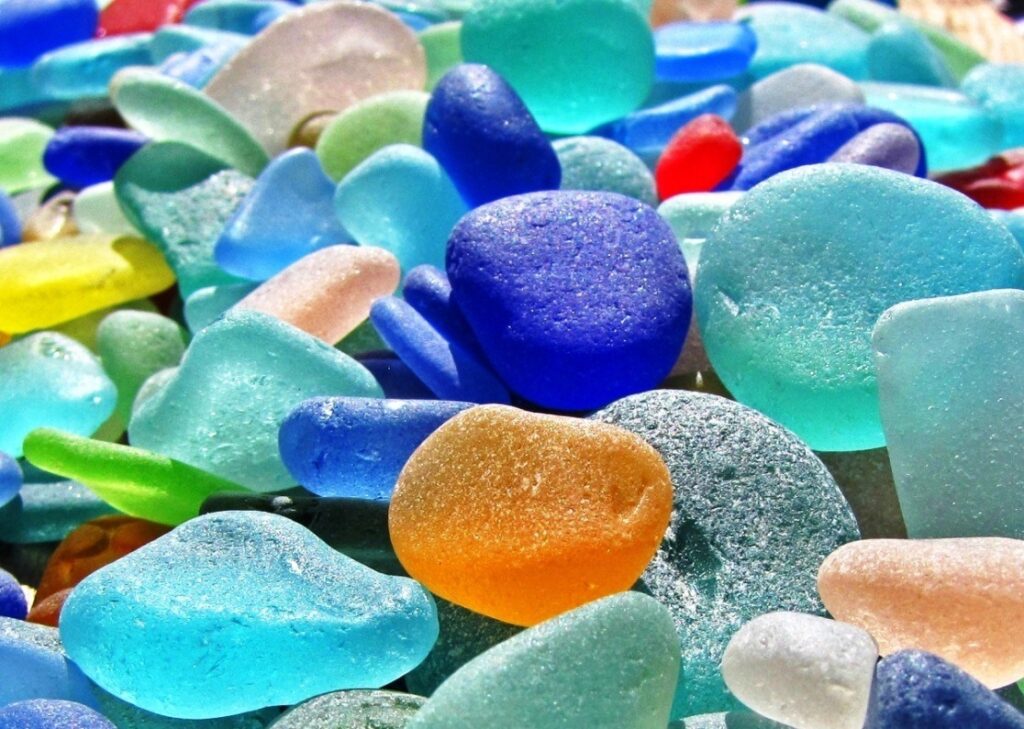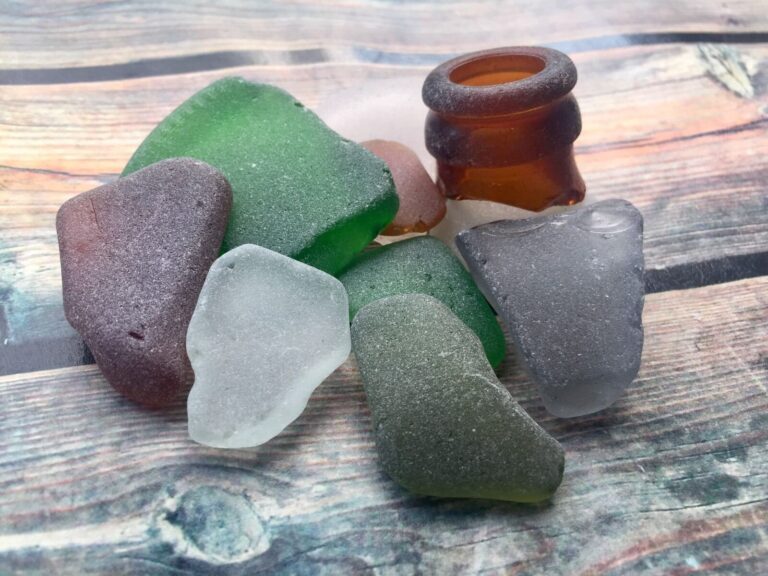Polishing sea glass is a delightful and creative process that transforms ordinary beach finds into dazzling treasures. If you’ve ever wondered how to enhance the natural beauty of sea glass, you’re in for an enjoyable journey.
However, Polishing sea glass is easy! First, soak it in soapy water for a bit. Scrub with an old toothbrush, then rinse and let it dry. If you want it extra shiny, use a special machine called a gem tumbler. Put the sea glass inside with polishing stuff and a bit of sugar or cornmeal. Turn it on, and check every 12 hours until it’s super shiny.
Now, it is like a pretty gem, ready for cool jewelry! Easy and fun!
Let’s dive into the fascinating world of polishing sea glass and discover the magic within these coastal treasures.
Gathering and Sorting Sea Glass

Gathering and sorting it can be a delightful and rewarding activity. They also known as beach glass, are weathered and tumbled glass found along shorelines. Here’s a guide
Gathering Sea Glass:
- Choose the Right Beaches:
- Look for beaches with a history of glass dumping or where glass bottles and other items may have washed ashore.
- Remote or less-visited beaches may have more sea glass since it’s less picked over.
- Timing Matters:
- Visit the beach during low tide when more of the shoreline is exposed, making it easier to spot sea glass.
- Keep an Eye on Color:
- Sea glass comes in various colors, with some being rarer than others. Common colors include green, brown, and white, while less common colors include blue, red, and violet.
- Search in Gravelly Areas:
- They tend to collect in gravelly or rocky areas rather than sandy ones. Focus your search on these locations.
- Be Patient:
- Finding it can take time, so be patient and enjoy the process. The more time you spend, the better your chances of finding unique pieces.
Sorting Sea Glass:
- Basic Sorting:
- Sort sea glass by color and size. This can be a simple initial sorting to get a sense of what you have.
- Advanced Sorting:
- Once you have a collection, consider sorting by the grade of wear. Some collectors categorize sea glass into categories like “craft grade” (well-worn with smooth edges), “jewelry grade” (small, well-worn pieces suitable for jewelry), and “collector grade” (rare colors or unique shapes).
- Clean the Sea Glass:
- Rinse the sea glass in fresh water to remove any salt or debris. Let it dry thoroughly before sorting to get a better look at the colors.
- Use Trays or Containers:
- Sorting it can be made easier by using trays or containers with dividers. This helps keep the different colors and grades organized.
- Identify Special Pieces:
- Look for unique or rare pieces. These might include bottle stoppers, marbles, or pieces with interesting patterns.
- Document Your Finds:
- Keep a record of where and when you found certain pieces. This can add a personal touch to your collection.
Getting Ready: Materials for Seaglass
- Sea Glass:
- Gather sea glass from beaches or shorelines. Choose pieces with interesting shapes and colors.
- Dish Soap:
- Use a mild dish soap for soaking the sea glass.
- Bowl:
- A large bowl for mixing the soapy water and soaking the sea glass.
- Old Toothbrush:
- Use an old toothbrush for scrubbing the sea glass in the soapy water.
- Strainer:
- To rinse the sea glass after scrubbing.
- Towel:
- Place the sea glass on a towel to dry after rinsing.
- Gem Tumbler (Optional):
- If you want an extra shiny finish, a gem tumbler can be used.
- Polishing Compounds:
- Special polishing compounds designed for use in a gem tumbler.
- Sugar or Cornmeal (Optional):
- Some people add a bit of sugar or cornmeal to enhance the polishing process in the tumbler.
- Water Source:
- Access to cold water for rinsing the sea glass.
Simple Polishing Steps for Sea Glass
- Soaking in Soapy Water:
- Mix dish soap and water in a bowl.
- Let the sea glass soak in the soapy water for one to two hours.
- Scrubbing with Toothbrush:
- Use an old toothbrush to scrub the sea glass in the soapy water.
- Pay attention to the little cracks where dirt can hide.
- Rinsing:
- Put the sea glass in a strainer.
- Run cold water over it until all the soap is washed away.
- Place the sea glass on a towel to dry.
- Optional Step – Gem Tumbler:
- To achieve an extra shine, use a gem tumbler.
- Add special polishing compounds and a bit of sugar or cornmeal.
- Turn on the machine and check every 12 hours until the sea glass looks really shiny.
- Final Inspection:
- Once the sea glass is dry and polished, inspect it to ensure it meets your desired level of shine.
Troubleshooting Tips for Common Sea Glass Polishing Issues
- Scratches and Blemishes:
- If scratches or blemishes appear, go back to a finer grit sandpaper and revisit the polishing steps. Gradually work your way up to finer grits to achieve a smoother surface.
- Uneven Polishing:
- Uneven polishing may occur if not enough time is spent on each grit. Ensure each step is thorough before progressing to the next. Focus on consistent pressure and motion.
- Over-polishing:
- Lastly, if the glass loses its natural shape or becomes too thin due to over-polishing, consider stopping the process and appreciating the glass in its current state. Exercise caution to avoid excessive material removal.
Ensuring Safety During Sea Glass Polishing: Safety Considerations

- Wear safety glasses to shield your eyes from particles and consider using a dust mask for respiratory protection.
- Work in well-ventilated areas to minimize dust and fume inhalation.
- Choose a stable, flat surface to prevent accidents; use a non-slip mat if necessary.
- Handle sandpaper, polishing compounds, and tools with care, following recommended usage guidelines.
- Dispose of used materials properly, adhering to local regulations for waste disposal.
FAQ’s
How can you make sea glass shiny?
For a glistening finish, use a tiny amount of coconut oil on the surface, rubbing it with your fingertips. This will make your sea glass instantly shiny and glowing.
What makes sea glass smooth?
Sea glass gets its smooth texture from the tumbling action of water, waves, and sand, which smoothens the glass over 5 to 50 years.
Should you clean sea glass?
Yes, it’s recommended to clean sea glass. Use an old toothbrush and plain soap and water, followed by buffing the metal for added sheen.
Can you polish sea glass with olive oil?
Yes, you can. Apply a small dot of high-grade olive oil or baby oil on a clean cloth and gently work it into the sea glass for a gentle shine.
What is the rarest color of sea glass?
Orange is the rarest sea glass color, followed by turquoise, red, and yellow. Rarity is often determined by the scarcity of the original glass color.
How long does it take for sea glass to get smooth?
Sea glass takes 20–40 years, sometimes up to 100–200 years, to acquire its smooth texture through the tumbling process of waves and sand.
Can you polish sea glass with vegetable oil?
Yes, you can. Rubbing a small amount of food-grade or cosmetic oil, such as olive oil, gently onto the sea glass can bring back its shine.
What makes sea glass frosted?
The familiar frosted surface of sea glass is created when soda and lime leach out during prolonged immersion in saltwater, resulting in a pitted texture.
How do you make sea glass color?
Mix Mod Podge with food coloring, add dish soap, paint glass pieces, and apply frosted finishing spray for creating colored sea glass.
What’s the difference between beach glass and sea glass?
Sea glass is weathered glass found in saltwater, while beach glass comes from freshwater and is often less frosted in appearance.
Does sea glass glow in the dark?
Yes, Some sea glass, if made with uranium dioxide, can glow under a black light, adding a magical touch to these beach treasures.
Is sea glass just broken glass?
Yes, sea glass is broken glass transformed by the tumbling action of water into beautiful, flawless gems with no rough edges.
Does vinegar clean sea glass?
Yes,Vinegar is a natural and inexpensive way to clean sea glass without harsh chemicals. Some collectors prefer the frosted look and use baby oil to enhance colors.
Does sea glass have value?
The value of sea glass is determined by factors such as its beauty, rarity, and unique qualities. The shape of the sea glass also plays a role in determining its value.
What do you oil sea glass with?
You can use any oil, such as baby oil, coconut oil, or mineral oil, to bring out the color and reduce frost on sea glass, depending on personal preference
Final Words
Polishing sea glass is a simple yet rewarding process that turns weathered beach finds into sparkling gems. By soaking the glass in soapy water, scrubbing with a toothbrush, and rinsing thoroughly, you can bring out the beauty of each piece.
Moreover, For an extra shine, consider using a gem tumbler with polishing compounds and a bit of sugar or cornmeal. The result is not just polished glass; it’s a radiant gem ready for crafting stunning jewelry. Enjoy the journey of transforming sea glass and let each piece tell its unique story of the ocean’s artistry.

